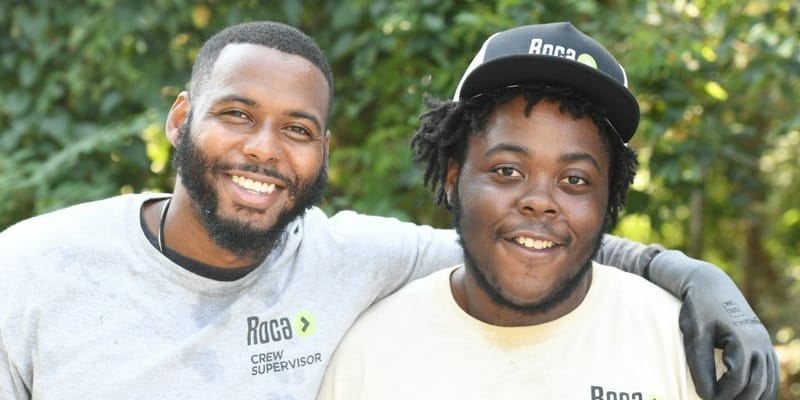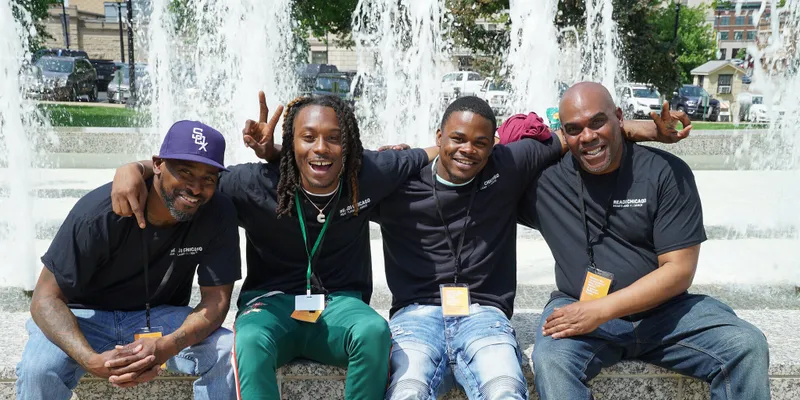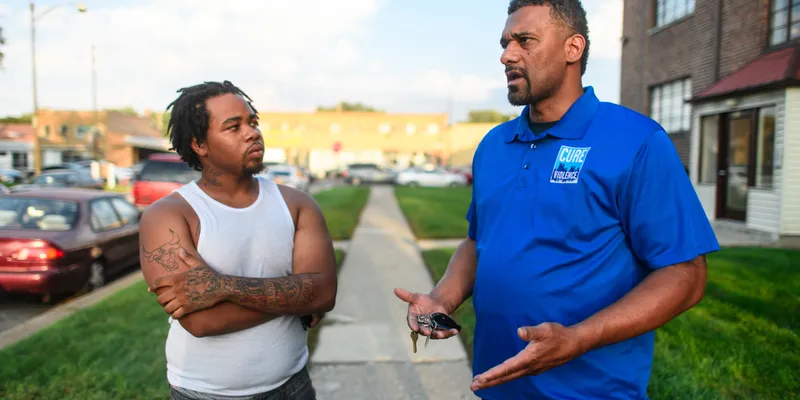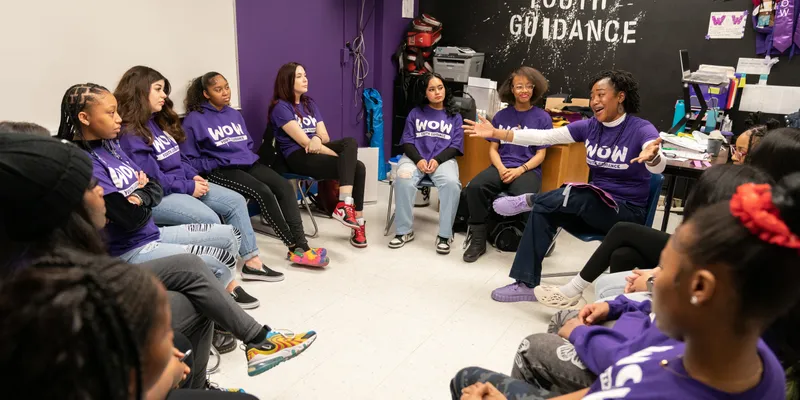Community-led violence prevention
- Issue Areas
- Justice and public safety
Strategy overview
Community connections to stop violence: Community-led violence prevention initiatives seek to reduce crime, especially gun violence, through relationships between community members and those at high risk for being involved with violence. Community-led violence prevention initiatives take different forms depending on the community context but often include some combination of violence interruption conducted by credible messengers, mentorship or counseling, case management, and transitional employment. Some community-led violence prevention programs work with hospitals to provide trauma-informed services to survivors of violence, often referred to as Hospital-Based Violence Intervention Programs (HVIPs). While police may serve as partners for some models, they do not lead the initiative.
Identifying those at risk: For nearly all community-led violence prevention programs, stopping violence before it starts requires identifying the individuals or groups at the highest risk of participating in or being subject to violence. Most community-led programs rely on staff with existing knowledge and relationships to identify high-risk individuals. Many programs also seek to engage with victims, victims’ families, or those with past justice system involvement. Some programs have experimented with predictive analytics using data from the criminal justice system or other sources, or a combination of data-driven and relationship-based referrals.
Violence interruption: Many initiatives include mediation and de-escalation services delivered by violence interrupters, who are individuals with strong roots in the communities experiencing violence and frequently bring lived experience with the justice system. Violence interrupters are typically employees of social service agencies or community-based organizations who build relationships with high-risk groups or individuals, detect emerging conflicts, and de-escalate conflicts before they turn violent. Violence interrupters can play an important role in capturing on-the-ground information about the nature of inter-group conflict and what mediation tactics are most effective. Violence interrupters also sometimes support de-escalation and healing after shootings occur.
Connections to services for those at highest risk: While evidence shows that community-led interventions can reduce violence on their own, these efforts can be strengthened with connections to additional services that help break cycles of violence and crime. Community-led programs can help make connections to services such as transitional housing and/or legal support, especially for individuals with past justice system involvement. Many violence prevention programs include workforce development elements, such as work readiness training, career coaching, and transitional jobs that pay a living wage. Services may also include formal mentorship programs, case management, and mental and behavioral health supports.
Several community-based models that have been rigorously evaluated demonstrate positive results in reducing violence and increasing educational attainment. Further research is needed to demonstrate consistent, long-term positive results.
A 2025 systematic review found that the Cure Violence model effectively reduced shootings and killings in cities such as Chicago, New York City, and Cali, Colombia. The systematic review emphasizes the importance of fidelity to the model and how contextual factors can influence the program’s effectiveness.
A 2022 quasi-experimental study found that the Advance Peace program effectively reduced gun violence in Sacramento, California.
A 2023 randomized control trial of the READI program showed statistically significant impacts on shooting and homicide arrests among participants who were referred by outreach partners. However, effects were insignificant for the overall study sample (which included additional participants identified by predictive analytics, rather than community partners), and arrest rates for other violent crimes did not decrease.
A 2024 randomized control trial of the Choose to Change program found that youth who participated in the program were 39% less likely to be arrested for a violent crime (and 31% less likely to be arrested for any crime) compared to their peers who did not participate in the program.
Conduct outreach through credible messengers: When staffing the program, leaders should hire influential individuals with strong roots and credibility in the community for outreach and violence interruption roles. Individuals with lived experiences similar to those at high risk for violence are often most effective at building long-lasting relationships with participants. They can also help ensure the program reflects local assets and needs. Program leaders should be prepared to train and support these individuals, recognizing that they might lack experience in a traditional workplace, particularly if they were formerly incarcerated.
Multiple pathways for relentless engagement: Successful programs develop robust referral systems through community members, partner organizations, and/or predictive data analysis. Programs should train staff to be persistent in their outreach, recognizing that the groups or individuals at highest risk for violence might be the most difficult to engage. Repeated attempts at recruitment through multiple channels may be needed to persuade high-risk individuals to take advantage of programs and services.
Formal cross-sector partnerships: Community-led violence prevention initiatives are often key elements of a broader local strategy to reduce violence. An increasingly common way to institutionalize cross-sector collaboration is through Offices of Violence Prevention (OVPs), which can be established at the state, county, or local levels and are often administered through the local health department, the Mayor’s office, or another local administrator. These offices or departments can enhance community-led work through funding, coordination, and capacity-building. Partner organizations should meet regularly to share information, review lessons learned about effective approaches to reach high-risk groups, and analyze data to understand what’s working and where.
Interventions rooted in behavioral science: Research shows behavioral science can effectively reduce violent behavior by helping individuals self-regulate in stressful situations. Cognitive behavioral therapy (CBT) is a behavioral science approach that helps individuals regulate their thinking and lead with measured, rather than impulsive, responses. Rigorous studies have shown that mentoring and coaching that incorporate CBT methods can effectively reduce violent behavior.
Clear safety protocols: Community-led programs often engage with individuals or groups at a high risk for participating in violence. To ensure the well-being of program participants, staff members, partners, and community members, program leaders should develop clear safety protocols and procedures. This can include providing off-site or private workspace or transitional housing for participants who have received threats, proactively monitoring for threats to participants’ safety, and de-escalating interpersonal conflict when necessary.
Trauma-informed service delivery: Witnessing or experiencing gun violence causes distress and trauma, which can impact other health, social, and economic outcomes. Historically underserved communities experience this trauma at disproportionately high rates. Research also shows that past victimization increases the likelihood of future involvement in violence – therefore, trauma-informed services, including mental health supports, are critical to breaking cycles of violence. Staff of community-based programs should be trained on trauma-informed methods to avoid re-traumatizing victims and support healing. The Trauma Recovery Center model offers an evidence-based approach to providing comprehensive, culturally-relevant services.
Take an asset-based approach: Many programs intentionally focus on participants’ assets, not deficits. For example, program staff with lived experience in a community (such as violence interrupters) might lack traditional workforce experience, but bring the unique influence and proximity needed to reach highest-risk individuals. As another example, programs with mentoring or therapy elements sometimes encourage mentors to focus on participants’ strengths and future goals, rather than dwell on their past justice system involvement.
Leverage relationship-based referrals to reach high-risk individuals: Programs must take care with how they define and identify high-risk participants to avoid unfairly targeting individuals and groups. Unfair targeting, or the perception of it, can damage trust and undermine a program’s future efforts. In general, predictive algorithms come with a risk of bias in their models, so algorithmic referrals should be reviewed by staff and partners with knowledge in the community. Research demonstrates a combination of human and algorithmic referrals yields better results than either approach in isolation, as community members bring contextual knowledge that predictive algorithms cannot account for.
Community-based organizations: Despite the variation in specific models, community-based organizations (CBOs) are always at the heart of community-led violence prevention initiatives. These organizations understand the historical context and root causes of violence in communities, and they often know the individuals most at risk and their families. In some cases, CBOs design and implement a culturally relevant program model. In other cases, CBOs work with a technical assistance provider, such as Cure Violence, to adapt and implement an evidence-based program model in their community.
Community members: Community-based organizations should engage residents throughout the program design and implementation to ensure the program is appropriately tailored for the community. Influential, trusted community members such as faith leaders can play an important role in helping programs build goodwill in the community and connecting them with high-risk individuals. Faith leaders can also help survivors and their families navigate the trauma associated with victimization.
State and local government: State and local governments can convene partners across sectors to develop and implement a shared strategy, including community-led initiatives as a key component. Government leaders should establish departments or offices dedicated to reducing violence, such as Offices of Violence Prevention. Multi-year funding commitments from state and/or local governments are also crucial to sustaining community-led violence prevention initiatives over time.
Health systems: Health systems can be involved in community-led violence prevention efforts in multiple ways. In some models, referred to as Hospital-Based Violence Intervention Programs (HVIPs), hospitals lead or support service delivery for survivors of violence. Public health agencies might help coordinate efforts across multiple partners through structures such as Offices of Violence Prevention. Clinicians can also educate community members about available programs, services, and safety best practices.
School systems: Some programs work in schools and/or with school-aged youth. Staff from these programs often partner with school administrators or educators to identify high-risk youth or connect with program participants.
Social service providers: High-risk individuals, survivors, and justice-involved individuals may need help accessing stable housing, food, or mental or behavioral health services. Social service providers, such as those that provide counseling or transitional housing, can help ensure these needs are met in collaboration with outreach workers.
Law enforcement: Although law enforcement is not centered in community-led violence prevention efforts, police can partner with community-based organizations to help identify individuals and groups at high risk of violence. Police departments also track and maintain data about violence that community-based organizations might use to inform their approach and assess whether their efforts are working.
Culturally relevant implementation: Jurisdictions should use evidence-based approaches such as Advance Peace or Cure Violence Global that incorporate persistent outreach, credible messengers, and violence interruption. While the key features of these evidence-based models apply across contexts, the intended audience, geographic focus, types of credible messengers, and high-priority services vary by community. Quantitative data can provide a foundation for understanding violence trends and patterns, and additional insights gathered through community outreach can help illuminate root causes of violence.
Persistent, long-term relationship-building: Building relationships with high-risk individuals, from the point of identifying them through helping them transition into the workforce, often requires persistence and consistent engagement. This approach acknowledges that some initial participants will leave the program and must be re-engaged, that some will participate in violence while enrolled, and that behavioral changes may take several years.
Adequately resource community-led initiatives: Local leaders should make sustained, multi-year commitments in community-led violence prevention to ensure that initiatives have sufficient human and financial resources to withstand changes in the political climate. Inadequate resources can hinder implementation and undermine the overall credibility of community-led initiatives. Staff needed will vary by model and community context (such as geographic size, population, and number of high-risk individuals), but key roles often include on-the-ground staff (in the Cure Violence model, each front-line worker typically has a caseload of 15-20), a supervisor to oversee day-to-day activities, a program manager or director, and an executive director. Larger organizations might have additional administrative staff, such as a development director or chief financial officer. Organizations must also budget for overhead costs such as physical office space and technology tools needed, including secure data storage platforms.
Ongoing professional development: Professional and leadership development programs can help prepare staff to deliver culturally relevant, trauma-informed services. Program leaders should also ensure that violence interrupters and other frontline workers are equitably compensated and supported, recognizing that many outreach workers work non-traditional hours and are exposed to trauma in their day-to-day work. Finally, program leaders can benefit from training and networking opportunities to help them plan for the program’s long-term sustainability, such as training on how to apply for grant funding, if needed.
Data-driven continuous improvement: When measuring the impact of community-led violence prevention efforts, quantitative data can illuminate trends in outcomes (such as rates of gun violence) by time of day, geography, and demographic group. However, information on preventive measures (such as how many mediations were conducted, with whom, whether they were successful, and why) requires violence interrupters to log qualitative data. Organizations should train and coach employees to ensure that data are collected regularly and consistently by different staff members (see this report for more guidance on data collection), while also adhering to data protection and confidentiality protocols. Programs can then use these data to understand what tactics are working, why, and how to continuously strengthen program delivery.
Number of mediations or violence interruptions conducted and percent considered successful: Recording details about mediation or violence interruption activities, including background information about the conflict and the techniques that were used, can help organizations pinpoint what’s working and why. Because these data might contain sensitive or personal details, organizations should establish secure data entry and storage protocols and be transparent with staff and communities about how the data are being used to improve the program.
Frequency of and year-over-year percent change in violence: Programs should track the total number of incidents of violence by type (including homicides and non-fatal shootings), as well as disaggregate these data by demographic group and sub-geography (such as ward or census tract) to understand patterns and where violence is most concentrated. Leaders can overlay these data with areas where violence interrupters are active to assess whether violence interruption efforts are having their intended impact, interpreting data with caution and keeping in mind that other factors also influence community-level outcomes.
Return on investment: Violence incurs real social costs (such as personnel and administrative costs related to arrest, prosecution, and incarceration) as well as opportunity costs (such as the unrealized earning potential of someone who is incarcerated). Although models for calculating return on investment vary, experts agree that benefits outweigh costs. For example, researchers estimate that the Safe and Successful Youth Initiative in Massachusetts yielded a cost savings of $5.10 for every dollar invested. Another evaluation of the READI program in Chicago estimates a benefit-to-cost ratio of at least 4 to 1 (and perhaps as high as 18 to 1) for each dollar invested.
Resources
Evidence-based examples
|
|
Outcome Area |
This ranking reflects how these approaches are scored in one of the major government- or philanthropy-led clearinghouse resources. For more: https://catalog.results4americ... |
|---|---|---|
|
Chicago CRED (Create Real Economic Destiny) is a community-based violence prevention program that engages young people involved in gang violence and provides holistic support based on five pillars, including street outreach to engage those most at risk of being involved in violent crime, therapy, life coaching, education, and job training to remove individuals from high-risk circumstances.
|
|
|
|
Choose to Change® (C2C®) is designed to support youth who are at high risk of violence involvement, school disengagement, or justice system contact through combining trauma-informed therapy with intensive mentoring and wraparound services to help youth manage their reactions to high-stakes situations, thereby reducing their likelihood of justice system involvement.
|
|
|
|
Detects and interrupts potentially violent conflicts by deploying trained, credible violence interrupters and outreach workers into communities
|
Supportive neighborhoods |
|
|
Project Longevity is a group violence prevention initiative based in Connecticut, and is a collaborative initiative between law enforcement, social services, and community organizations that aims to reduce gun violence and other violent crime.
|
|
|
|
Intensive 2-year program combining transitional jobs with cognitive behavioral therapy, case management, coaching, and other support services
|
High-quality employment Supportive neighborhoods |
|
|
Intervention focused on addressing trauma, lowering involvement in criminal activity, and increasing employment
|
High school graduation High-quality employment Stable and healthy families Supportive neighborhoods |
|
Contributors

Brent Decker
Brent Decker serves as the Chief Program officer for Cure Violence Global, where he is responsible for overseeing all local, national, and international program implementation, oversight and curation of training for the Cure Violence ecosystem, and collaboratively setting and steering the strategic direction of the organization. Before joining Cure Violence, Mr. Decker worked on a number of social justice and community health projects in Latin America. Mr. Decker earned a masters degree in public health from Tulane University.

Chandler Hall
Chandler Hall is the associate director for Gun Violence Prevention at American Progress. Prior to joining American Progress, he worked for the University of Chicago Urban Labs, researching the impact of cognitive behavioral therapy techniques in violence prevention programs. Hall received his bachelor’s degree in political science and legal studies from the University of Massachusetts Amherst and his master’s degree in public policy from the University of Chicago Harris School.

Charles Ransford
Charlie Ransford serves as the Director of Science and Policy as well as the Director of Communications for Cure Violence Global (CVG). Mr. Ransford is responsible for all communications, public relations, and federal policy for CVG, and additionally leads on online trainings, publications, and research related to the Cure Violence approach. Mr. Ransford earned a masters of public policy from the University of Chicago.

Dr. Chico Tillmon
Chico Tillmon, PhD, is Executive Director of the CVI Leadership Academy, the first national training program designed to build the leadership capacity of those working to reduce violence in vulnerable communities. He previously served as Executive Director of the READI National Center for Safer Communities and led youth safety and violence prevention programs at the YMCA of Metro Chicago. A national expert in violence prevention, reentry, and nonprofit leadership, Dr. Tillmon serves on the Black and Brown Peace Consortium leadership team and has worked for over a decade with youth, direct service providers, and returning citizens. He was honored by President Biden in 2021 and is a recipient of numerous awards, including the 2025 Erica Ford Peacemaker Award, the 2022 UIC Alumnus of the Year, and the 2018 Congressional Veterans Braintrust Award.







